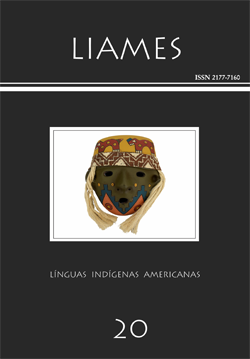Resumo
O Aimará é uma língua que é falada principalmente no Peru e na Bolívia. Até o momento, relativamente pouco foi documentado sobre a arte verbal aimará. Nesse sentido, analisamos uma canção tradicional gravada no altiplano peruano. Oferecemos uma análise musical e linguística da estrutura poética não prosódica da canção. Fornecemos detalhes sobre as figuras retóricas / literárias utilizadas para a produção / formação dos versos: a) o verso octossilábico, b) o homeoteleuton (este último é uma figura retórica que consiste na semelhança no final das palavras finais dos versos) e c) as características melódicas e rítmicas. Também delineamos as estratégias sintáticas, morfológicas e semânticas utilizadas/usadas/presentes na formação dos pares semânticos. Isto revela categorias semânticas que não seriam evidentes / não se manifestariam em uma análise linguística tradicional. Além disso, a análise musical confirma as observações de trabalhos anteriores sobre a percepção equivocada de uma anacruse musical. Concluímos que análises rigorosas e científicas da arte verbal requerem considerar a construção de significados por meio da prática e do diálogo.
Referências
Arnold, Denis Y. (2014). Los ritmos del textil: Comparaciones entre las formas cantadas y tejidas de las tejedoras amerindias. Jornadas Andinas de Literatura Latinoamericana 11: 2014, 4-8: Heredia, Costa Rica. Disponible en: https://vdocuments.mx/los-ritmos-del-textil.html
Arnold, Denis Y.; de Dios Yapita, Juan (1998). Río de vellón, río de canto. Cantar a los animales, una poética andina de la creación. La Paz. Bolivia: Facultad de Humanidades y Ciencias de La Educación. Carrera de Literatura. Universidad Mayor de San Andrés.
Beyersdorff, Margot (1986). La tradición oral quechua vista desde la perspectiva de la literatura. Revista Andina 4: 213–236.
Boodberg, Peter Alexis (1955). Syntactic metaplasia in stereoscopic parallelism. In Alvin P. Cohen (1979) (ed.), Selected works of Peter A. Boodberg, pp. 184-185. Berkeley: University of California Press.
Classen, Classen (1990). Sweet colors, fragrant songs: Sensory models of the Andes and the Amazon. American ethnologist 17(4): 722-735. https://doi.org/10.1525/ae.1990.17.4.02a00070
Coler, Matt (2014). A grammar of Muylaq’ Aymara: Aymara as spoken in Southern Peru. Leiden: Brill. https://doi.org/10.1163/9789004284005
Coler, Matt; Nicholas Q. Emlen; Edwin Banegas-Flores (2020). Vowel deletion in two Aymara varieties. Italian Journal of Linguistics 32(1): [To appear]
d’Harcourt, Raoul & Marguerite (1925). La musique des Incas et ses survivances. Paris: Librairie Orientaliste Paul Geuthner.
Fabb Nigel (2017). Linguistics and literature. In Mark Aronoff; Janie Rees-Miller (eds.), The handbook of linguistics, pp. 446-465. John Wiley & Sons, Ltd. https://doi.org/10.1002/9781119072256.ch22
Fox, James J. (1977). Roman Jakobson and the comparative study of parallelism. In D. Armstrong; C.H. van Schooneveld (eds.), Roman Jakobson, echoes of his scholarship, pp. 59-90. Lisse: Peter de Ridder.
Herder, Johan Gottfried von (1782 [1993]). Vom Geist der Ebräischen Poesie: Eine Anleitung für die Liebhaber derselben, und der ältesten Geschichte des menschlichen Geistes i Werke in zehn Bänden, 5.
Jakobson, Roman (1966). Grammatical parallelism and its Russian facet. In Krystyna Pomorska; Stephen Rudy (eds) (1987), Language in literature, pp. 145-179. Cambridge: Harvard University Press.
Karttunen, Frances; Lockhart, James (1980). La estructura de la poesía náhuatl vista por sus variantes. Estudios de cultura náhuatl 14: 15-64. Available at:
http://www.historicas.unam.mx/publicaciones/revistas/nahuatl/pdf/ecn14/204.pdf
Levin, Samuel R. (1962). Linguistic structures in poetry (Janua Linguarum 23). The Hague: Mouton.
Lowth, Robert (1829). Lectures on the Sacred Poetry of the Hebrew Scriptures. New York: J. Leavitt.
Mannheim, Bruce (1987). Couplets and oblique contexts: The social organization of a folksong. Text-Interdisciplinary journal for the study of discourse 7(3): 265–288. https://doi.org/10.1515/text.1.1987.7.3.265
Mannheim, Bruce (1998). “Time, not the syllables, must be counted”: Quechua parallelism, word meaning, and cultural analysis. Michigan discussions in anthropology 13(1): 238-281.
Mannheim. Bruce (2015). All translation is radical translation. In Carlo Severi; William F. Hanks (Eds.), Translating worlds: The epistemological space of translation (Special issues in ethnography theory series), pp. 199-219. Chicago: Hau Books.
Mannheim, Bruce; Vleet, Krista E. Van (1998). The dialogics of southern Quechua narrative. American Anthropologist 100(2): 326–346.
Pigott, Charles M. (2013). The lyrical creation of community: song as a catalyst of social cohesion in Andean Peru. AlterNative: An International Journal of Indigenous Peoples 9(4): 335-350.
Sperber, Dan; Wilson, Deirdre (1990) Rhetoric and relevance. In John. Bender; David Wellbery (Eds.), The ends of rhetoric: History, theory, practice, pp. 140- 156. Stanford CA: Stanford University Press.
Stobart, Henry (2006). Music and the poetics of production in the Bolivian Andes. Ashgate Publishing, Ltd.
Stobart, Henry; Cross, Ian. (2000). The Andean Anacrusis? British Forum for Ethnomusicology 9: 63–92.
Tedlock, Dennis (1974). trans. 1985. Popol Vuh: The Mayan book of the dawn of life. New York: Touchstone.
Turino, Thomas (1989). The coherence of social style and musical creation among the Aymara in Southern Peru. Ethnomusicology 33(1): 1-30. Available in: http://www.jstor.org/stable/852167
Urton, Gary (1997). The social life of numbers: A Quechua ontology of numbers and philosophy of arithmetic. Austin: University of Texas Press.
Waugh, Linda R. (1982). Marked and unmarked: A choice between unequals in semiotic structure. Semiotica 38(3-4): 299--318. https://doi.org/10.1515/semi.1982.38.3-4.299

Este trabalho está licenciado sob uma licença Creative Commons Attribution-NonCommercial 4.0 International License.
Copyright (c) 2020 Matt Coler, Patrice Guyot, Edwin Banegas-Flores


